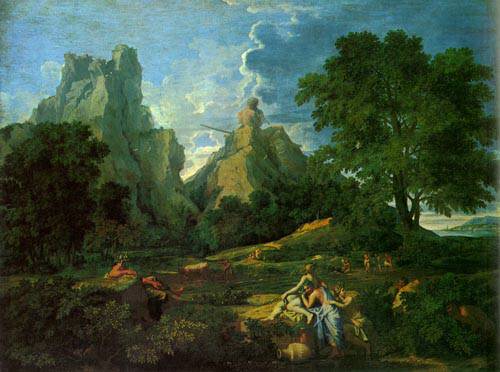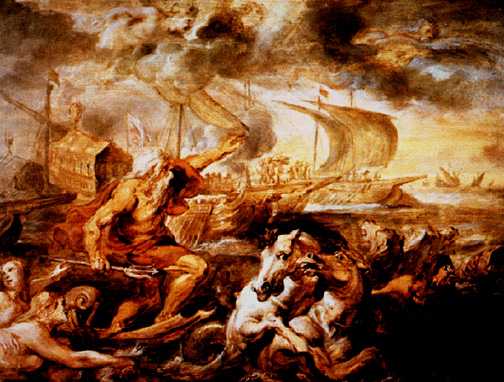Poseidon and the Sea Deities
Poseidon and Sea Deities
POSEIDON became established as the mighty god of the seas. His wife was AMPHITRITE.
PONTUS (“sea”), produced by Gaia in the first stages of creation.
OCEANUS, the stream of Ocean, and his mate Tethys, titans who produced thousands of children, the Oceanids.
TRITON, son of Poseidon and Amphitrite, a merman, human above the waist, fish-shaped below (many male deities of the deep are often so depicted). His most distinguishing characteristic was that he blew on a conch shell and thus he was known as the trumpeter of the sea.
PROTEUS, a pre-Olympian deity who became an attendant or son of Poseidon and Amphitrite, was an old man of the sea who could foretell the future and could also change his shape at will.
NEREUS was another old man of the sea and, like Proteus, could foretell the future and change his shape. He was a son of Pontus and Gaia. Nereus mated with one of the Oceanids (Doris) and became the father of fifty daughters called NEREIDS; three of these are important: THETIS, GALATEA, and AMPHITRITE. Nereids are beautiful and often, but not always, depicted as mermaids; and usually they can change their shape.
PELEUS AND THETIS
Zeus learned from Prometheus the secret that Thetis was destined to bear a son mightier than his father, and so he avoided her. Instead, a mortal named Peleus wooed and won her, not without difficulty, because she changed herself into all sorts of things, a bird, a tree, and a tigress. The wedding of Peleus and Thetis was one of the most famous in mythology and their son Achilles (the hero of the Trojan War) did become mightier than his father.
ACIS, GALATEA, AND POLYPHEMUS
The second Nereid, Galatea, fell in love with ACIS, the handsome son of a sea-nymph, who was daughter of the river-god Symaethus, in Sicily. To her dismay, she was wooed by the Cyclops POLYPHEMUS, son of Poseidon. This monstrous and boorish giant, with one eye in the middle of his forehead, tried to mend his savage ways but to no avail. Galatea would listen to his love songs, cowering in the arms of her lover Acis. Enraged with jealousy, Polyphemus finally turned on the two lovers. He pursued Acis and hurled a jagged mass, torn from the mountain, which buried him completely. But with the help of his beloved goddess of the waters, Galatea, Acis was transformed into a river-deity, fulfilling his ancestry.
Landscape with Polyphemus

Nicolas Poussin
POSEIDON AND AMPHITRITE
The third Nereid, Amphitrite, became the wife of Poseidon, and herein lays her importance.
Poseidon himself looks very much like his brother Zeus, a majestic and bearded king, only more severe and harsh. He can be identified by his trident, a long, three-pronged fork resembling a fisherman's spear. Poseidon has many moods, just like the sea that he controls. He is often ferocious and relentless in his hostility, as in the case of his devastating anger against Odysseus for the blinding of his son, the Cyclops Polyphemus.
Poseidon, as the earthshaker, was a god of earthquakes as well as of storms. His virility and power are symbolized by his association with horses and bulls.
SCYLLA AND CHARYBDIS
Poseidon made advances to SCYLLA (a granddaughter of Pontus). Amphitrite was jealous and threw magic herbs into Scylla’s bathing place, which turned her into a vicious monster, encircled with a ring of dog’s heads. She lived in a cave in the stormy Strait of Messina between Sicily and Italy. With her was CHARYBDIS, daughter of Poseidon and Gaia, an equally formidable ally, who drew in mountains of water and spewed them out again. Scylla and Charybdis were a menace to heroes such as Odysseus.
Another version of this myth has become famous because it is told by Ovid. A mortal GLAUCUS was transformed into a sea-god. He became enamored of Scylla, who rejected him. He turned for help to the sorceress Circe, but she fell in love with him and through jealousy poisoned the waters of Scylla's bathing place.
IRIS
Many were the progeny of the sea; some of them we shall meet later in saga, for example the Graeae, the Gorgons, and the Harpies. Progeny of the sea often appear grotesque or fantastic. At this point, however, we single out only IRIS, a beautiful descendant of Pontus and Gaia. Iris, fleet-footed and winged, is the lovely goddess of the rainbow, the meaning of her name. She is also (like Hermes) a messenger of the gods, only Iris often becomes the particular servant of Hera.
Neptune Calming the Sea

Peter Paul Rubens, 1635
Fontana del Tritone in the Piazza Barberini in Rome

Gian Lorenzo Bernini,1642
Triton. This snake-bodied sea-god is generally made out to be the son of Poseidon and Amphitrite, whom he escorts as they ride over the sea. He is memorably described by Ovid in the first book of the Metamorphoses, blowing his conch shell to order the Flood to recede, and these lines have inspired countless paintings and other works of art. Triton is also a significant ornament in gardens, parks, and city squares: a famous example of an urban fountain is the Fontana del Tritone in the Piazza Barberini in Rome, designed by Gian Lorenzo Bernini in 1642.
http://www.oup.com/us/companion.websites/9780195397703/student/materials/chapter7/rep_art/?view=usa